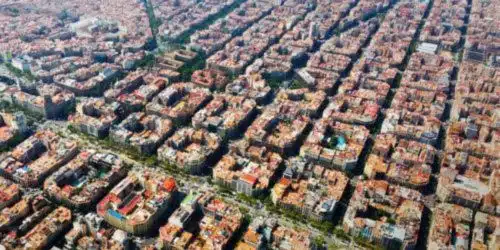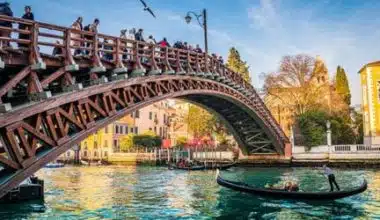Spain, a compelling Iberian Peninsula nation, is well known for its extensive history, vibrant culture, and stunning natural beauty. Beyond its enticing attractiveness, Spain is home to expansive cities teeming with life, each presenting a distinctive fusion of heritage and modernity. The largest cities in Spain will be explored in this blog post, along with information on their population sizes, cultural significance, and must-see sights. Let’s discover the urban patchwork that defines Spain, from the vivacious capital of Madrid to the beachfront of Barcelona.
Largest Cities in Spain By Population
There are many dynamic cities in Spain, each with its own distinct personality and allure. Several urban centers stand out in the largest cities in Spain in terms of population and importance. Let’s examine some of the largest cities in Spain in terms of population:
#1. Madrid: The Regal Capital
Madrid, Spain’s capital and biggest city, is the throbbing center of the nation. With a population of more than 3.3 million, this majestic city skillfully fuses a global vibe with a very Spanish character. Architectural wonders like the Royal Palace and the Puerta de Alcalá, which provide hints at the city’s regal past, serve as prime examples of Madrid’s opulence.
#2. Barcelona: A Mediterranean Gem
Barcelona, the second-largest city in Spain, is located on the country’s northeastern coast. Also, Barcelona, which has a population of about 1.6 million, is well known for its distinctive fusion of Gothic and Modernist architectural styles. Millions of tourists visit the captivating Basilica of the Sagrada Familia, the city’s most recognizable structure, each year. The renowned architect Antoni Gaud constructed it.
#3. Valencia: Where Tradition Meets Modernity
Valencia, which is the third-largest city in Spain and is located along its southeast coast, has a population of about 800,000. Also, Valencia, which is renowned for having a thriving culture, skillfully combines heritage and innovation. The City of Arts and Sciences, the jewel in the crown of the city, is a showcase for cutting-edge architectural marvels and a venue for cultural and entertainment events.
#4. Seville: A Flamenco Paradise
Seville, the fourth-largest city in Spain with a population of more than 690,000, is located in the center of Andalusia. For those looking for a real Spanish experience, Seville is the ideal location because of its fascinating history and charming environment. Visitors are invited to travel back in time and immerse themselves in the beauty of Moorish architecture and lush gardens at the city’s famous Alcázar, which is a UNESCO World Heritage Site.
#5. Zaragoza: A Tapestry of Cultures
Zaragoza, which is located in northeastern Spain and has a population of more than 660,000, is the fifth-largest city in the nation. Also, Zaragoza, which is renowned for its fascinating fusion of civilizations, prominently displays Roman, Islamic, and Christian influences. The Basilica de Nuestra Senora del Pilar, the city’s crown jewel, has exquisite baroque architecture and significant religious and historical value.
#6. Málaga: The Gateway to the Costa del Sol
Málaga, the sixth-largest city in Spain with a population of more than 570,000, is located on the breathtaking Costa del Sol. Golden beaches, a thriving nightlife, and a rich cultural legacy are all found in this sun-drenched paradise. The renowned artist Pablo Picasso was also born in Malaga, where tourists may visit the Picasso Museum and view a sizable collection of his creations.
Murcia, a lesser-known city in southeast Spain, is the seventh-largest city in the country and has a population of over 450,000. This undiscovered jewel enchants guests with its charming squares, intriguing architecture, and mouthwatering culinary scene. Murcia’s Cathedral, with its impressive baroque façade, stands as a testament to the city’s architectural prowess.
#8. Palma de Mallorca: Island Paradise
The capital and largest city of the Balearic Islands, Palma de Mallorca, is located on the beautiful island of Mallorca. With a population of over 430,000, Palma de Mallorca offers a unique blend of stunning natural beauty, historical sites, and a vibrant nightlife scene. La Seu Cathedral, the jewel in the crown of the city, is a stunning example of Gothic architecture and looks out over the Mediterranean Sea.
#9. Las Palmas de Gran Canaria: A Tropical Haven
Las Palmas de Gran Canaria, which is located on the beautiful island of Gran Canaria in the Canary Islands archipelago, is the ninth-largest city in Spain and has a population of about 380,000. With its glistening beaches, exciting festivals, and thriving cultural scene, this tropical refuge draws tourists. A look into the city’s colonial past can be found in Vegueta, the city’s historical area, which is a UNESCO World Heritage Site.
#10. Bilbao
The tenth-largest city in Spain’s Basque Country is Bilbao. It is less than 100 kilometers from the French border and situated on the country’s northern shore. The city has received numerous honors and prizes in recent years for its liveability, and its cultural offerings are well-known across Europe. A busy port, a robust banking sector (Bilbao is home to the global BBVA bank), the mining and ironworks sectors, and tourism all play a significant role in Bilbao’s GDP. As a result, the city has a very diverse economy.
What is Spain’s capital city?
Madrid is the capital of Spain. Madrid is the largest city in all of Spain, with a population of over 3.3 million. It is one of the largest by population and the most populous cities to visit in Spain.
What are the major cities in Spain?
The three largest cities in Spain are Valencia, Barcelona, and Madrid. Even though Spain is home to a wide variety of cities, these are the three largest and most well-known. Millions of people visit each one each year since they are all so different from one another.
What is the most visited city in Spain?
Spain’s most popular tourist destination is Barcelona. Barcelona receives more than 27 million visitors annually. Contrarily, while being the largest city in the nation, Madrid, the capital, only attracts 6 million tourists a year. Barcelona is popular with tourists because of its large range of attractions, fascinating architecture, and excellent dining options.
What is the most walkable city in Spain?
The largest and most walkable cities in Spain are Madrid and Barcelona. These two significant Spanish cities are listed among the top 50 walkable cities in the world, with Madrid tied for sixth place. Due to the proximity of its top attractions, Madrid and Barcelona are excellent cities for walking. It’s fairly simple to navigate the city streets on foot because they are so pedestrian-friendly.
Which currency does Spain spend?
Spain’s official currency is the euro (€). Spain is a member of the Eurozone, which uses the euro as its standard currency. The Spanish peseta was replaced as the currency of the nation by the euro, which was introduced in 2002. One euro is equal to one hundred cents, and the symbol for the euro is “€.” As a result, all money is exchanged, all prices are set in euros, and all banking activities are carried out in euros in Spain.
How much is $1 US dollar in Spain?
The exchange rate between the US dollar (USD) and the euro (EUR) can change as a result of several variables, including market forces and economic conditions. For the most recent exchange rate between the US dollar and the euro, it is recommended to contact a reputable currency exchange business or financial institution. These rates are subject to daily fluctuations. To determine the approximate worth of $1 US in Spain based on the current exchange rate, you can either utilize online currency converters or visit financial websites.
Does Spain use US dollars?
No, the US dollar is not the official currency of Spain. The euro (€) is Spain’s official currency, as was previously mentioned. In Spain, the US dollar is not frequently used as a form of payment or legal money. You would normally utilize euros for financial operations or purchases in Spain. If you intend to go to or conduct business in Spain, it is advisable to exchange your US dollars for euros.
Is the dollar strong in Spain?
There are still good deals to be found because the dollar’s value relative to the euro is still high and Spain and Portugal are less wealthy than the rest of Europe.
Foreign currency rates can affect the US dollar’s (USD) strength or weakness in Spain or any other nation. Numerous variables, such as economic conditions, interest rates, inflation rates, geopolitical events, and market mood, affect exchange rates.
These elements can alter the US dollar’s strength or weakness over time in Spain. It is advised to verify with a trustworthy currency exchange business, or financial institution, or refer to respected financial websites that offer the most recent exchange rate information to determine the current strength of the US dollar relative to the euro (EUR) in Spain.
How many states does Spain have?
In contrast to nations like the United States, Spain does not have states. In place of this, Spain is divided into 17 autonomous communities (comunidades autónomas) and two autonomous cities (ciudades autónomas), each of which has some degree of self-governance and decision-making authority.
These are the 17 autonomous communities:
- Andalusia (Andalucía)
- Aragon (Aragón)
- Asturias (Principado de Asturias)
- Balearic Islands (Islas Baleares)
- Basque Country (País Vasco/Euskadi)
- Canary Islands (Islas Canarias)
- Cantabria
- Castile and León (Castilla y León)
- Castilla-La Mancha
- Catalonia (Cataluña)
- Extremadura
- Galicia
- La Rioja
- Madrid (Comunidad de Madrid)
- Murcia (Región de Murcia)
- Navarre (Comunidad Foral de Navarra)
- Valencian Community (Comunidad Valenciana)
Spain has two autonomous cities in addition to the autonomous communities:
- Ceuta
- Melilla
These cities are under Spanish control and situated on Africa’s northern coast. Within the confines of the Spanish constitution, each autonomous community and city has its government, which has the authority to decide on specific issues including education, healthcare, and regional law.
What is Spain known for?
The many things that make Spain famous around the world and contribute to its rich cultural history are numerous. Here are some significant characteristics for which Spain is known:
- Vibrant Culture and Festivals
- Rich History and Heritage
- World-Class Art
- Beautiful Beaches and Coastlines
- Gastronomy and Culinary Delights
- Soccer (Football)
- Architectural Marvels
These are only a few of the things that make Spain famous. Travelers and lovers of culture, history, art, gastronomy, and other things find the nation to be enthralling and memorable due to its diversified landscapes, warm hospitality, and zeal for life.
What is the smallest city in Spain?
Castellfollit de la Roca, a town in the Catalan province of Girona, is arguably the smallest city in Spain. In Castellfollit de la Roca, homes cling to the edge of a steep basalt cliff, providing stunning views of the surrounding volcanic scenery. It is one of the smallest cities in Spain, with a population of roughly 1,000. Despite its tiny size, the town draws tourists who value its charm and natural beauty because of its distinctive and attractive environment.
Conclusion
The largest cities in Spain are a testament to the diversity and attraction of the nation, from the imperial majesty of Madrid to the bustling coastal metropolis of Barcelona. Whether you are attracted to Seville’s extensive history, Barcelona’s creative past, or Valencia’s sun-drenched coastlines, each city offers a distinctive experience that will leave an imprint on your trip to Spain.
Be sure to immerse yourself in the local culture, enjoy wonderful cuisine, and appreciate the energetic environment that defines each city as you tour these urban gems. The largest cities in Spain in terms of population are just waiting to be discovered; they beckon you to explore their enthralling tapestry of history, culture, and natural beauty. So gather your belongings, set out on a journey, and allow the largest cities in Spain by population to astonish you with their charm and attraction. ¡Viva España!
- 17+ Most Beautiful Cities in the World 2023, Revealed (Updated)
- BEST TIPS ON PLANNING A TRIP TO PORTUGAL
- HOW MANY COUNTRIES ARE THERE IN THE WORLD: Detailed List
- BRAZIL HOLIDAYS TO LOOK OUT FOR
- HOW TO TRAVEL FOR FREE: Top Secrets Revealed






